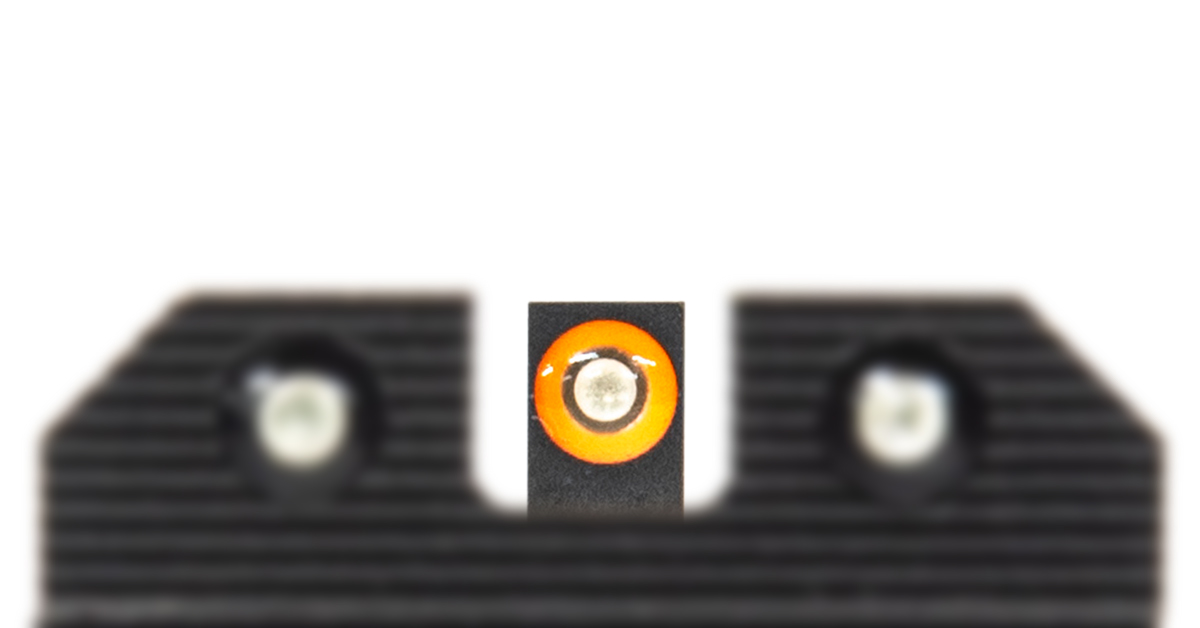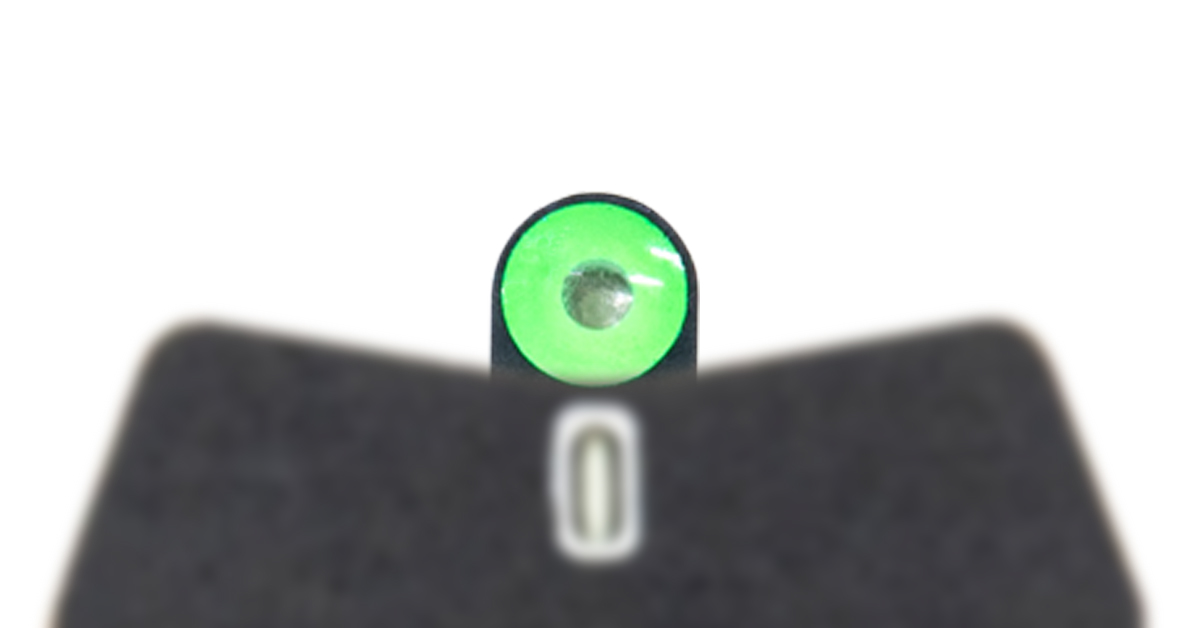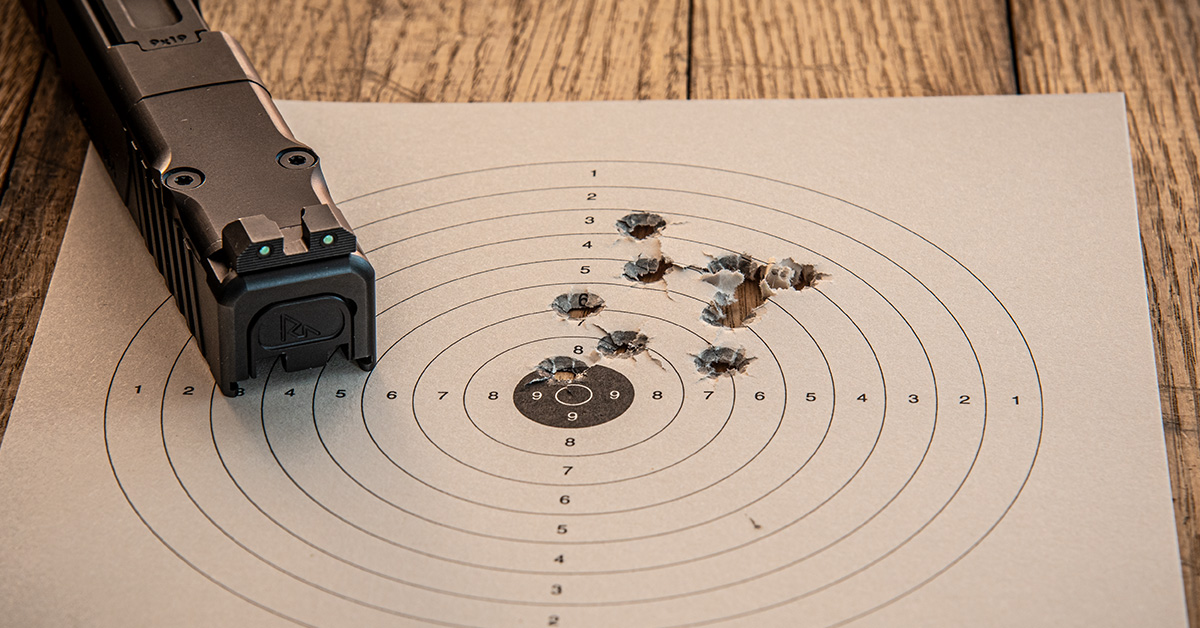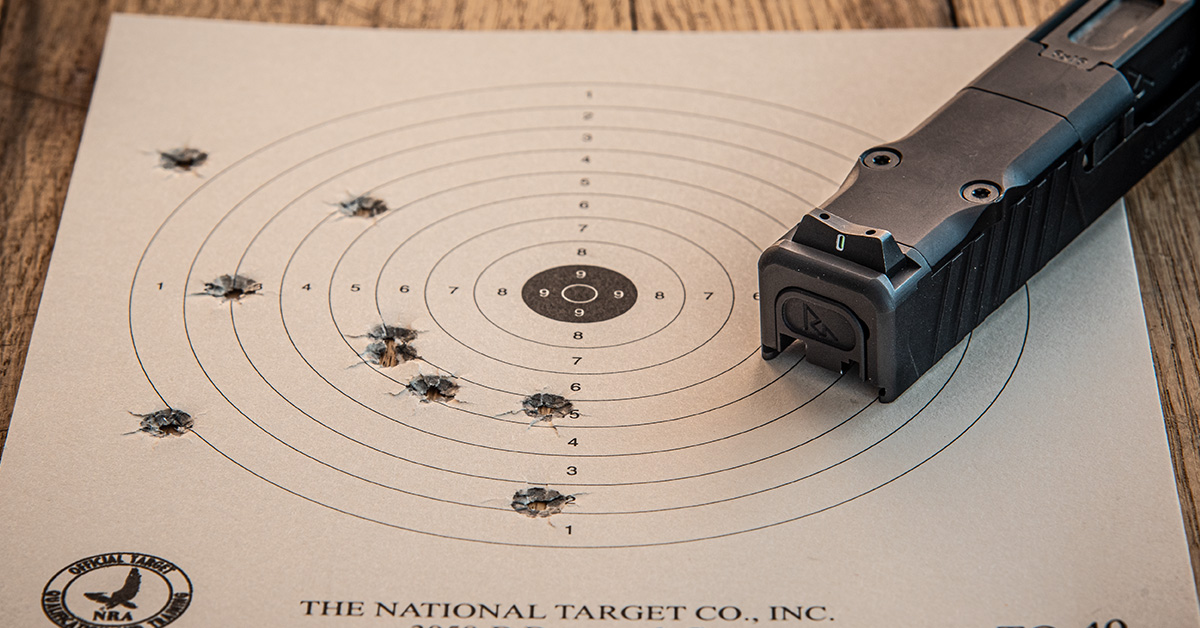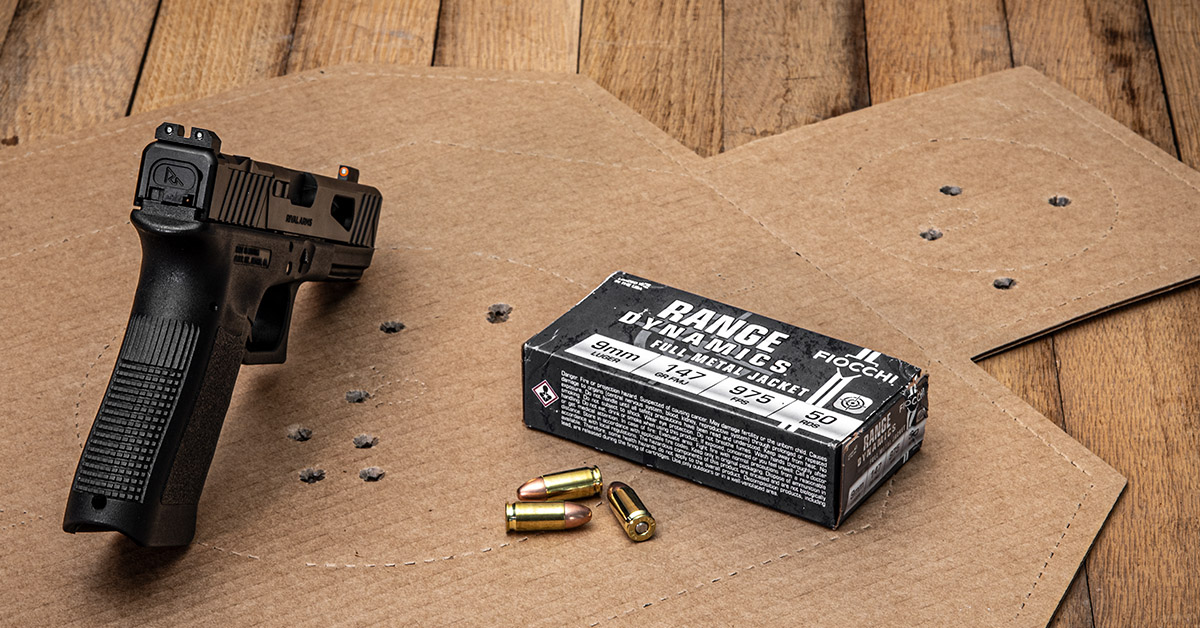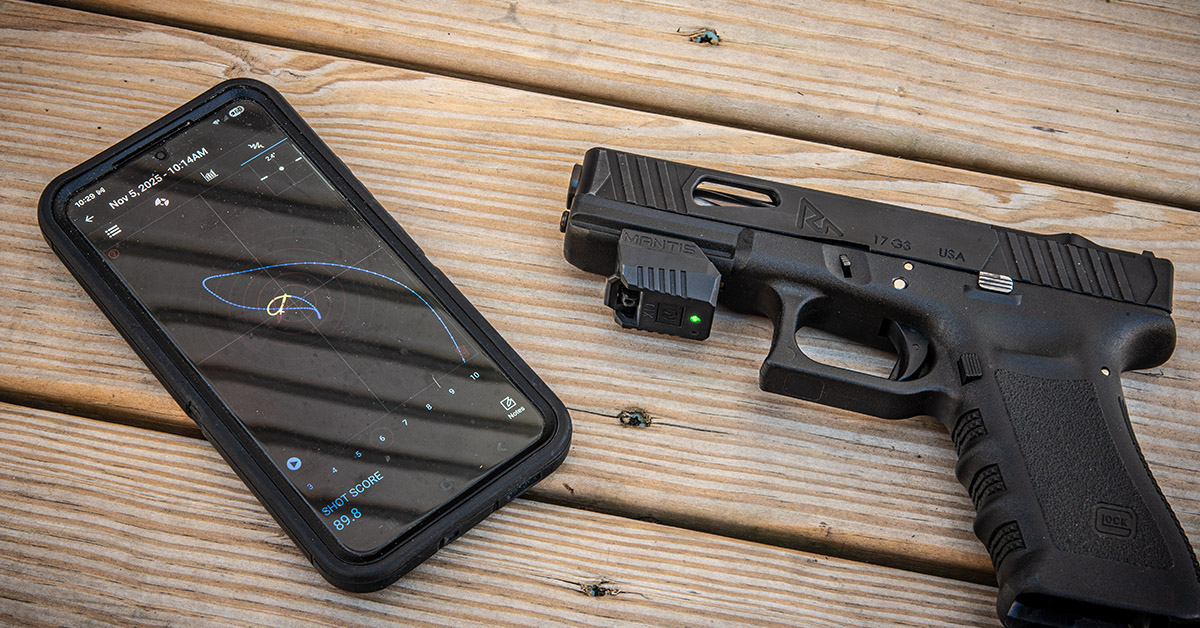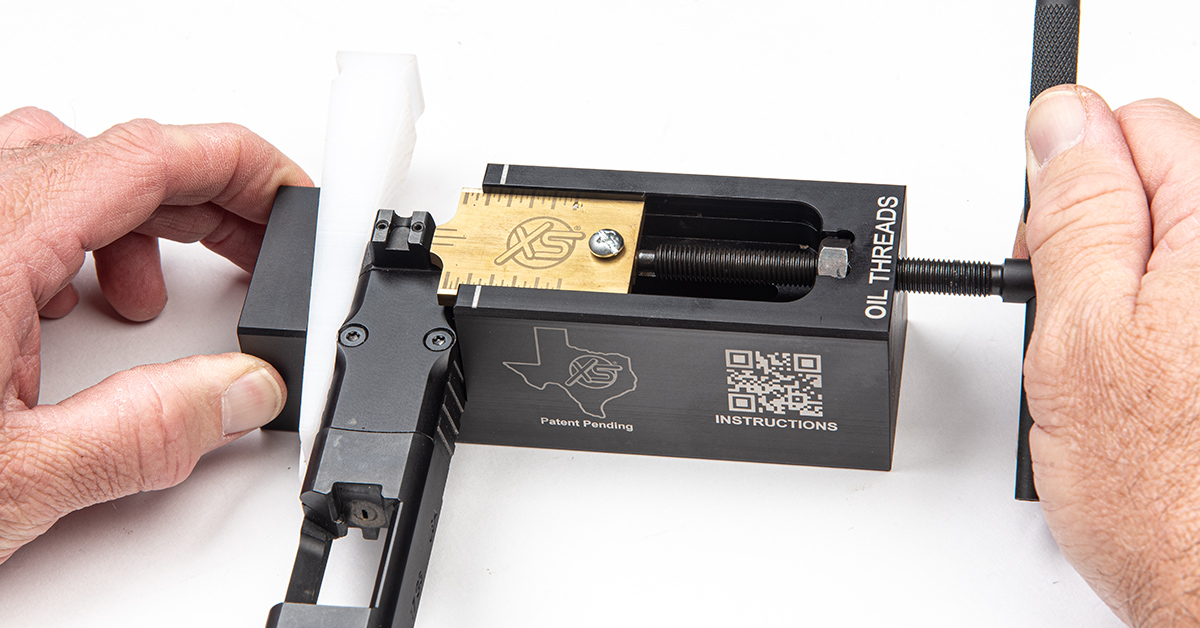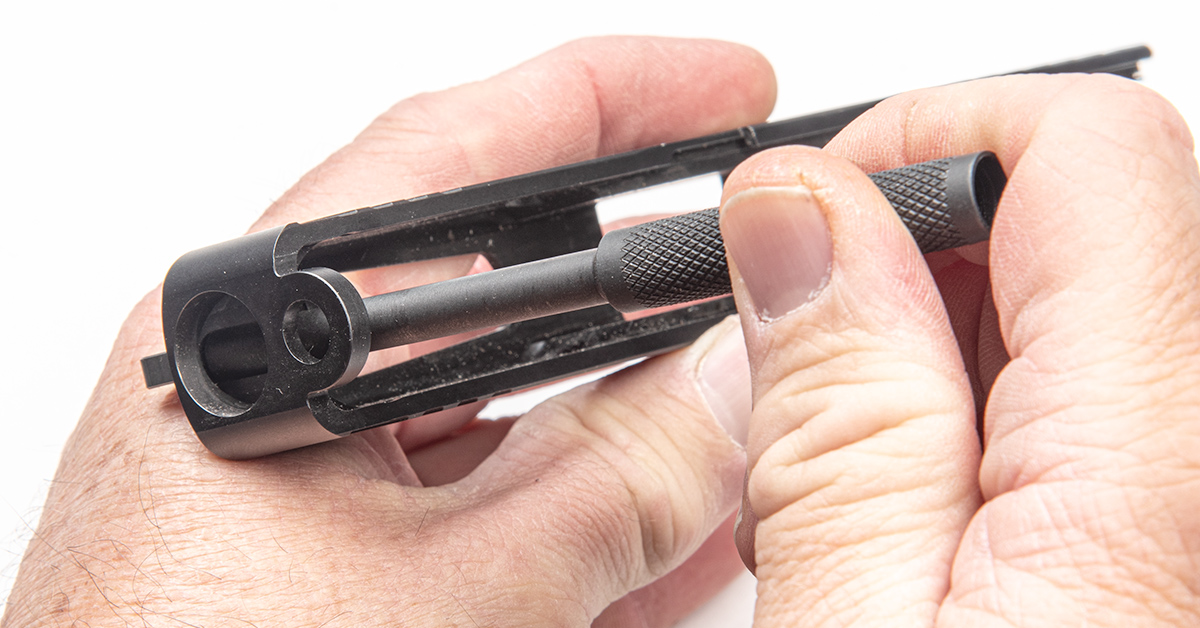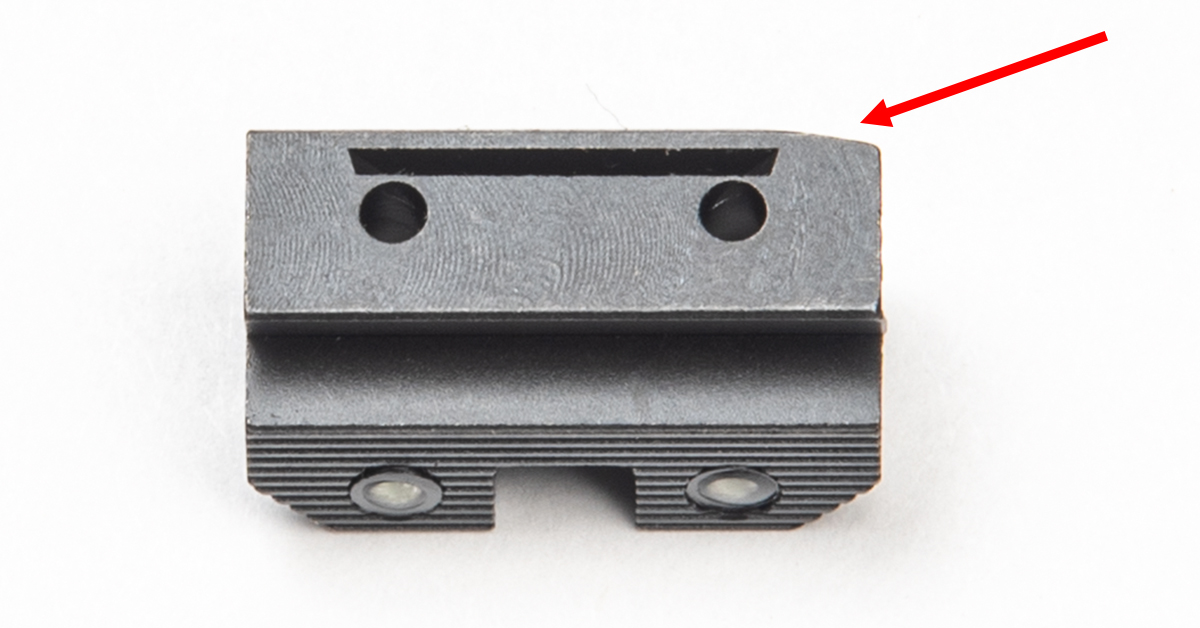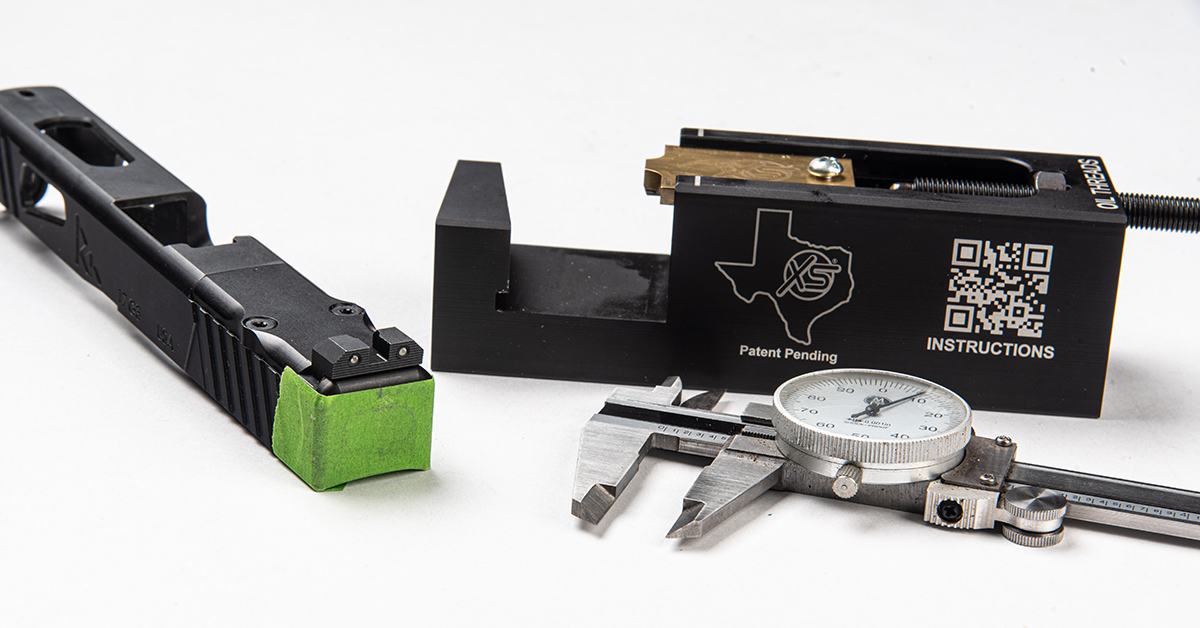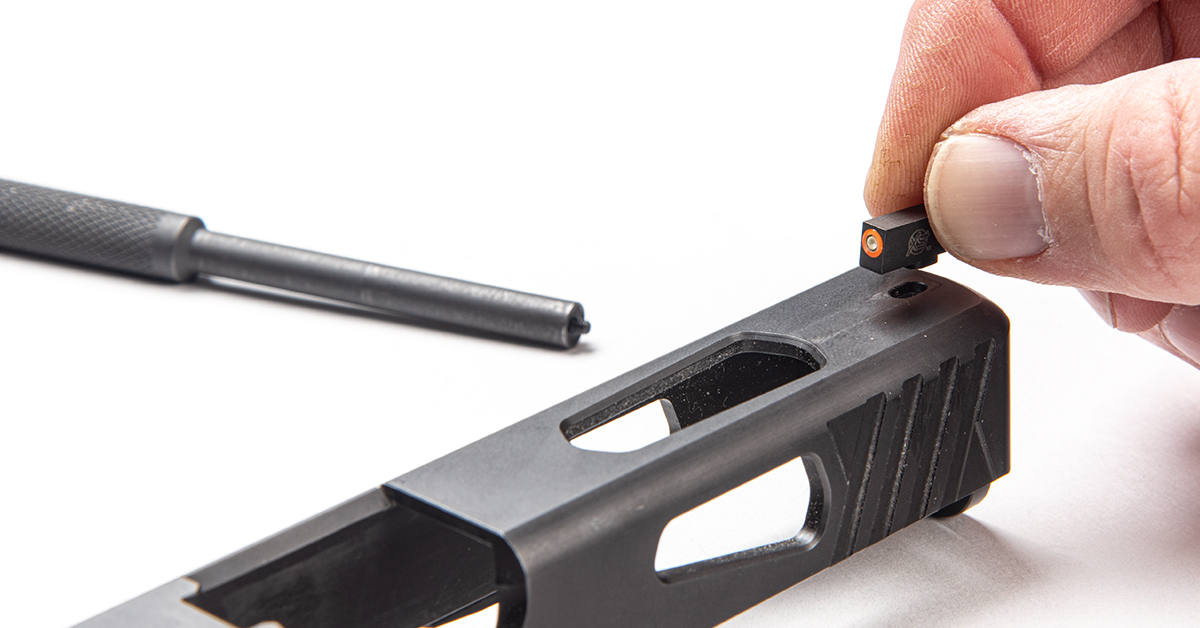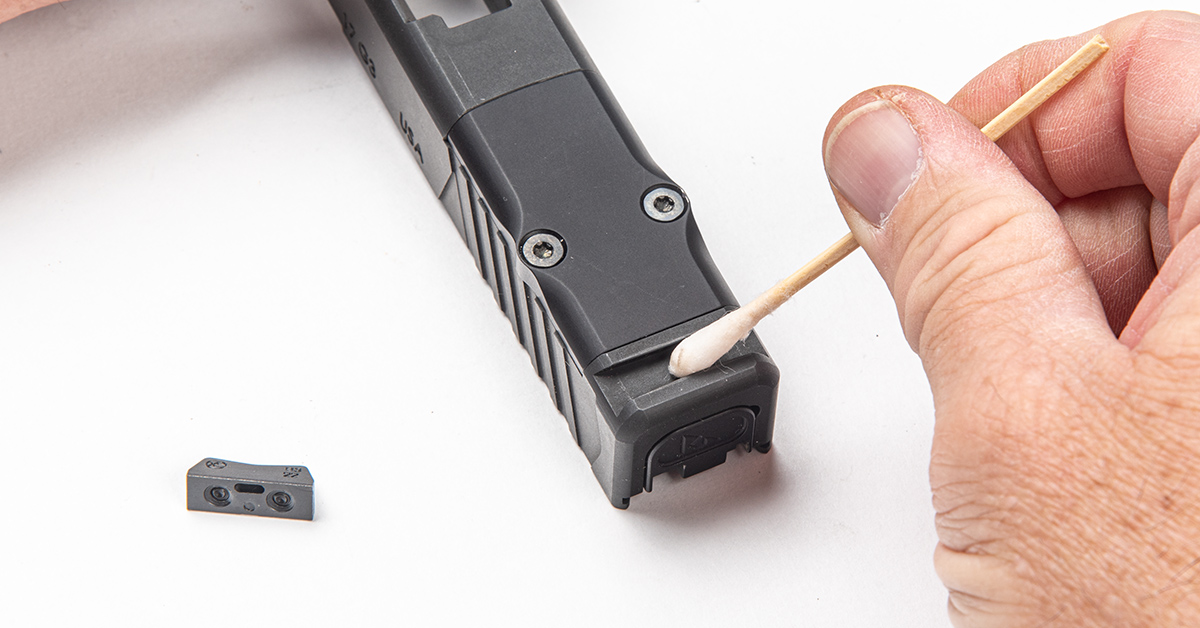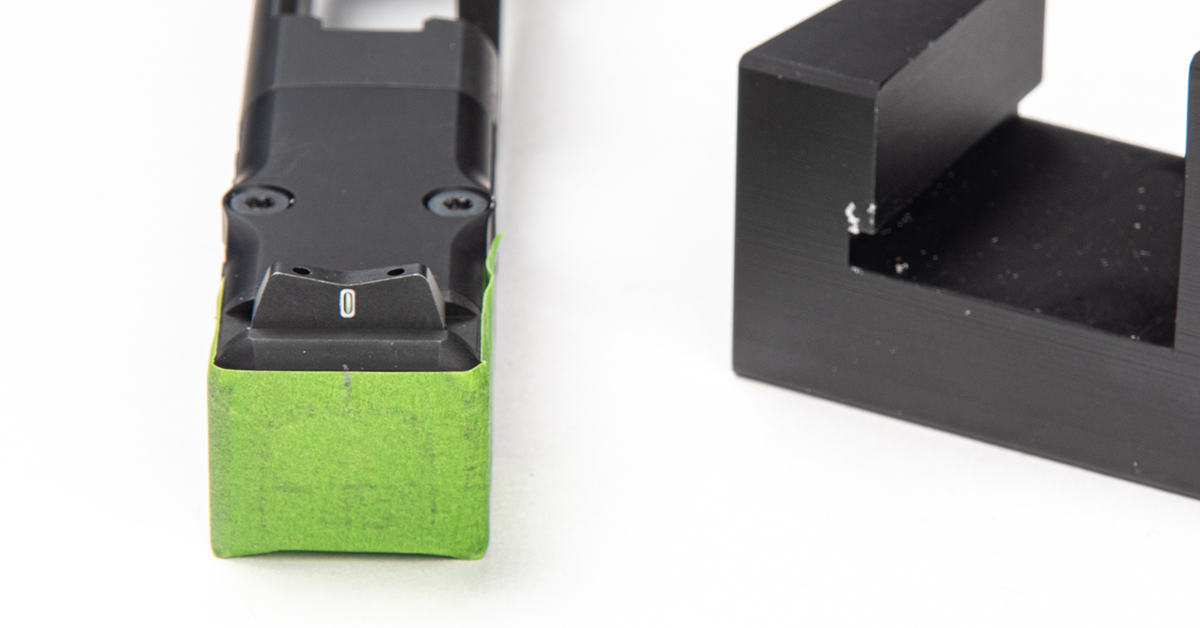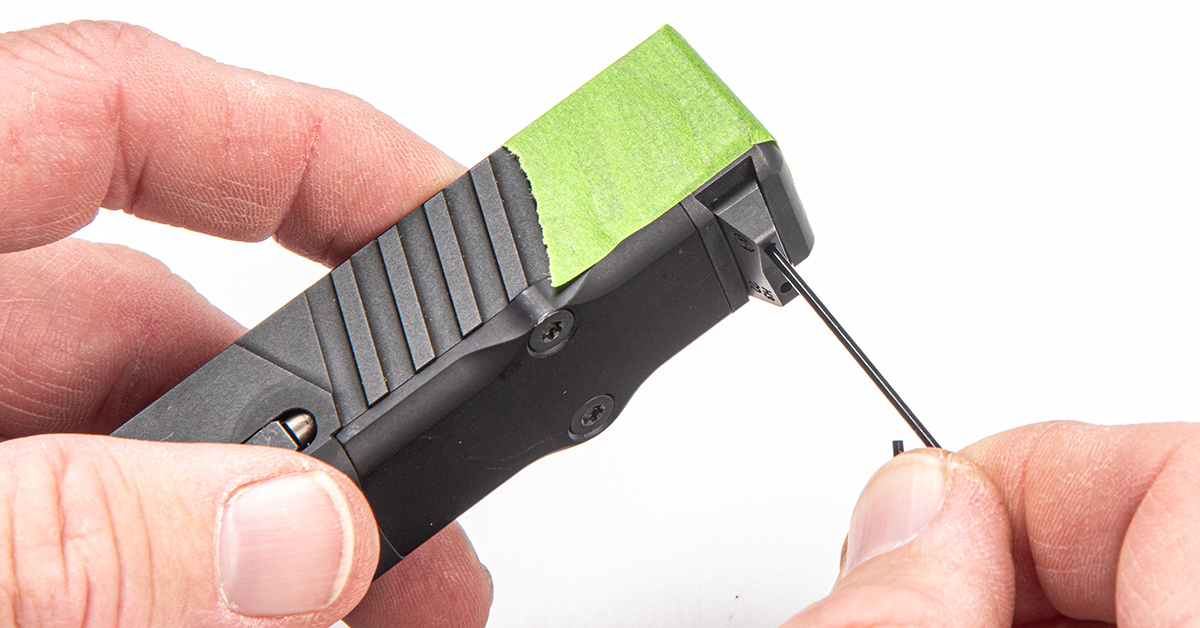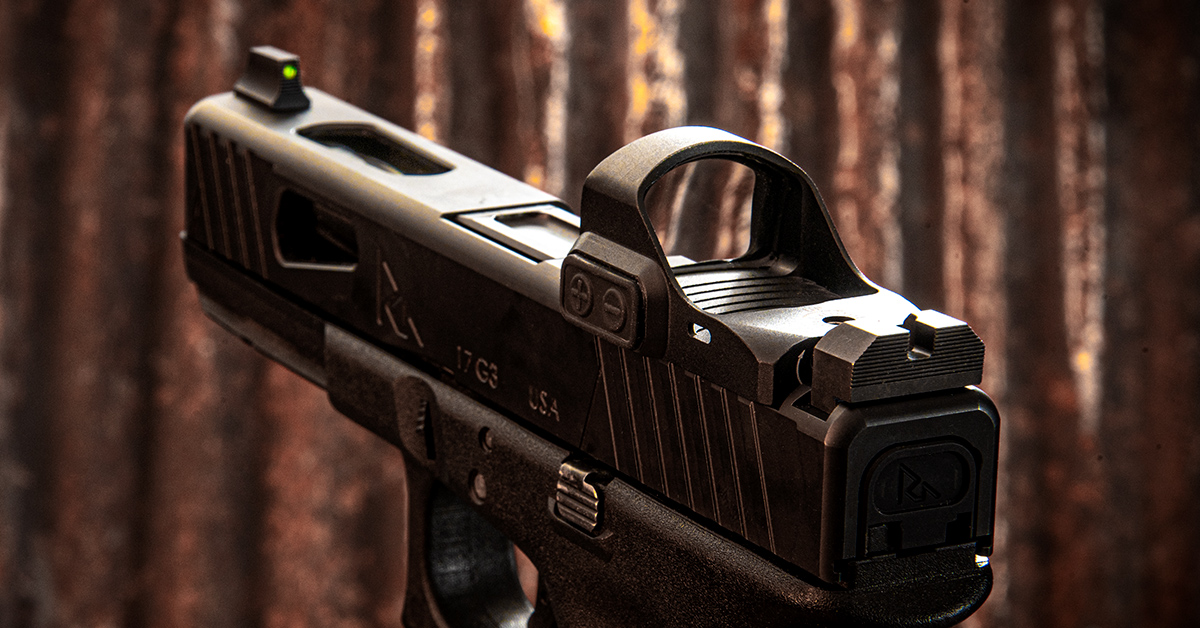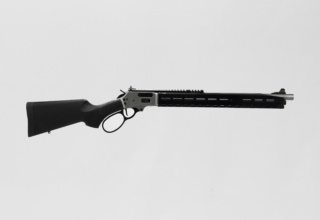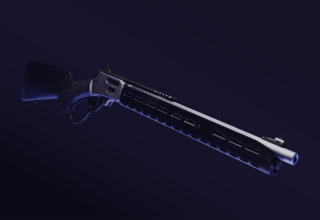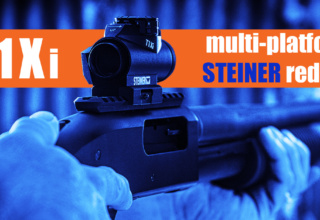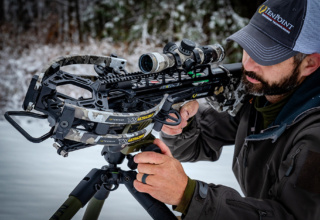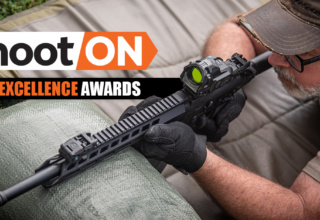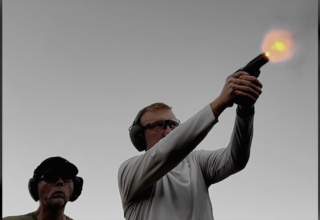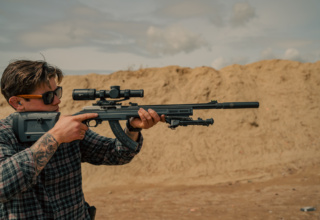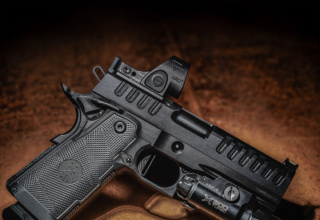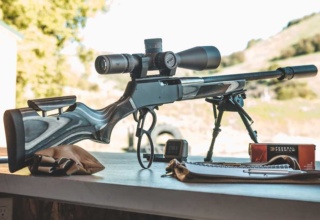There are many options available for open pistol sights, but which is best for you? Here, we break down the pros and cons of conventional post-and-notch sights and express sights for personal defense use.
by Rob Reaser
You gotta love the firearms aftermarket. It’s rather like an American supermarket in the eyes of, say, the typical European. There are choices. Many choices. There are so many choices, in fact, that it is often difficult to choose one product out of a herd of similar products.
Consider sight systems for pistols. There are oodles of reflex “red dots” or pistol-mounted optics (PMOs in modern parlance) ranging from import junk you wouldn’t want to put on a squirt gun to high-end models that, if you could afford them, might be money better spent on a large stash of training ammunition. Move over to the open, or iron sight category and the variations are seemingly endless. Do you want a minimalist front post/rear notch sight, a three-dot sight, tritium sight set, U-notch or square notch, fiber-optic sight, express sight…?
The list goes on.
For this discussion, we want to focus not on the scads of available sight systems and variations you could buy, but on the benefits and limitations of the two primary open-sight types you most likely will buy.
Why drill down on open sights at a time when the current trends all point to PMOs as being the thing in personal defense sight systems? Simple. Whether you favor a red dot or not, open sights are (or should be) a constant in the personal defense handgun equation. Open sights will never fail you, mechanically speaking, and they can be used in conjunction with many of the PMOs on the market today to serve as a backup system.
The question then becomes, what type of open sight system will serve you best? Again, there are choices. Aftermarket manufacturers put their own spin on this timeless sight concept, with variations in sizes, shapes, and enhancement features such as low-light tritium elements, high-visibility rings or dots for bright ambient light conditions, alignment dots, and front and/or rear fiber-optic elements.
But we’re not even going that far here. What we want to examine are the relative benefits and detractions of two specific open sight designs and how they translate to typical personal defense applications. We’re talking about conventional post-and-notch sights and express sights.
To illustrate this discussion, we tapped the experts at XS Sights — a company that has built an enviable reputation in the firearms industry for producing rugged, precision, and solution-driven sight systems for pistols, revolvers, shotguns, and rifles. So sturdy and reliable are XS Sights’ products that several of the top firearm manufacturers have leaned on XS Sights as part of their original equipment (OE) component roster, like Smith & Wesson, HK, and Remington.
An Evolving Sight Picture
Open sights — also referred to as iron sights — are simple enough in concept. They are comprised of two sight components spanning the front and rear of a firearm. These sights align with the barrel’s bore axis to provide two reference points to orient the barrel to the target.
Over the centuries, open sights have come in several forms — many of which are still in use due to the design of the host firearm. We could spend many words discussing the various open sight designs that were and that still are with us, but our concern here is open sights for use on personal defense handguns — more specifically, semi-auto pistols, as those are what most defense practitioners employ for home and EDC protection. For this application, two key factors must be considered:
- accurate shot placement
- fast sight picture acquisition
…in that order.
Accuracy First
A sight must ensure shooters can accurately place bullets where they aim the gun. This is non-negotiable. A gun that doesn’t hit where you intend to hit is worse than being of no value; it can be a devastating liability. If you miss the target, your attacker may succeed in the assault. Further, an errant bullet may result in collateral damage to property or an innocent person, and you are responsible for that. Accuracy, you see, should be your foremost priority.
Fast on Target
Working in support of accuracy is speed in getting on target. Given the high-stress, close-distance nature of a personal defense engagement, fractions of a second count. Your sight system must provide you with the fastest possible sight picture that allows you to deliver an accurate shot. Too slow and you may lose the fight.
Achieving maximum accuracy and speed is the goal — something that good trainers instill in their students. The question becomes, what type of open-sight system best provides this critical combination?
As you may expect, the answer is contingent upon several factors, not the least of which is the “what works best for you” component. That is something only you can determine through experimentation and diligent practice. Other considerations include gun size and practical range. Yet another is the application, or the likely scenario in which the gun would be deployed.
Let’s work through these considerations by first examining the two sight types put forward for this discussion.
Post-and-Notch Sight
Post-and-notch pistol sights are the progenitors of the early revolver sight design found most notably on such legacy arms as the Colt 1873 Single Action Army. This consisted of a narrow front blade sight and a channel machined into the revolver’s topstrap. From the shooter’s perspective, the front blade would be positioned in the “notch” formed by the topstrap groove, thereby rendering a functional sight picture with which to align the barrel with the target. These were not, though, the most precise elements for critical aiming.
As handguns advanced in accuracy potential and practical demand, more precise sights followed suit, with the post-and-notch sight configuration gaining the greatest respect and performance.
This is a prime example of a modern post-and-notch sight; here, the R3D 2.0 from XS Sights.
The post-and-notch design may seem boringly simple, but its ability to render ragged holes in targets is unmatched because it provides crisp and repeatable barrel alignment with the target. How it works is equally simple and intuitive. The top of the front post is aligned with the top of the rear sight. This ensures elevation consistency. For windage alignment, the front post is positioned in the center of the rear sight notch. Equidistant spacing between the sides of the front post and the inside edges of the rear notch comes naturally, much like centering a front post in the center of a rear peep sight or ghost ring sight with a long arm so equipped.
The post-and-notch sight is elementally designed for precise aiming, and so it delivers. Align the sights as described, center the top of the front post on the target, and fire.
The precision aiming capabilities of the post-and-notch system, though, does not necessarily mean that aiming comes quickly (although it can be in the hands of a trained and practiced shooter). Variations in the relative size of the front post and rear notch may mean more or less “dead space” to align the two. Too much space and centering the front post in the notch may be imprecise. Too little space and the shooter might struggle to see the gaps in certain lighting conditions. Both scenarios can lead to imprecise and slower sight alignment.
This is where modern features, like those found on the R3D 2.0 can help. From our experience shooting the R3D 2.0 across several pistol platforms, this system provides ideal geometry for exceptional sight visibility and finds the perfect balance between accuracy and fast sight picture acquisition. There is plenty of gap to quickly find the front sight but not so much as to diminish alignment within the rear sight notch.
In addition to this balanced configuration, the R3D 2.0 also comes with “assists.” The white alignment rings on each side of the rear sight, for example, host tritium vials in their centers. Ditto for the front sight post ring, which also includes an even larger and bolder orange or green outer ring. The high-visibility front ring and the white rear rings make for fast sight alignment in conditions where it would be more difficult to align sights without these enhancements, such as when working in dappled sunlight or in low ambient light conditions.
Express Sight
As its name implies, the express sight is designed primarily for speed, as in fast sight alignment and sight picture acquisition.
We should stop for a moment here and explain the difference between sight alignment and sight picture acquisition.
Sight alignment is simply aligning the front and rear sights relative to each other. In other words, aligning the front post in the center of the rear sight.
Sight picture acquisition also involves aligning the front and rear sights relative to each other but adds aligning the sights with the target. The sight picture is thus comprised of the three aiming elements: the front sight, the rear sight, and the target.
The express-style sight is all about acquiring the sight picture as quickly as possible. It does this in two ways. First, it relies on a large front sight dot or bead. It’s big and bold and you can’t miss seeing it. Second, this bead sits in the center of a shallow “V” formed by the clean-and-lean rear sight profile.
This is the DXT2 Pro Express Sight, also from XS Sights, in its correct alignment position. Instead of using a square post, the front sight is rounded, and this rounded post, defined here by a bright green focus ring, nestles in the valley of the rear sight. A proper sight picture with the express sight would place the front sight ring directly in line with the target. In other words, the front sight would cover the target.
For low light conditions, the DXT2 Pro Express Sight includes a tritium element in the center of the green or orange front focus ring and a tritium element positioned in the middle of a white alignment stripe on the rear sight. These enhancement deliver a visible aiming solution across all lighting conditions.
As an interesting side note, express sights were originally developed for hunters — most importantly for professional hunters (PHs) — pursuing Africa’s dangerous “Big Five” animals: lions, leopards, elephants, rhinos, and buffalo. Veteran safari hunters and their PHs quickly learned that conventional sights were of little use for aiming a long gun when a furious and wounded beast was barreling at you with only feet to spare. They needed a sight that would put them on target fast and not cause them to “get lost in the sights” in a high-stress, close-distance charge.
Express vs Post-and-Notch: Accuracy Test
So, the sum of it is that the post-and-notch sight is all about accuracy, the express sight about speed. The post-and-notch allows you to precisely align the sights relative to each other and to the target while the express sight gives you a cleaner and faster sight picture but generally does so at the expense of aiming precision.
The question is, does this matter in a personal defense firearm? Well, that depends on the gun and the application.
To illustrate the practical differences, we installed the XS Sights R3D 2.0 (post-and-notch) and the DXT2 Pro Express sights on two aftermarket Glock-clone slide assemblies and ran them on a shared G17 frame for continuity. Ammo consisted of Fiocchi’s Range Dynamics 147-gr. FMJ. We began with an accuracy test, firing 10 rounds each at ten yards, slow-fire.
The R3D 2.0 post-and-notch sights delivered a 1.725-inch group.
Shifting to the DXT2 Pro Express setup, the group size opened to 4.795 inches. That represents a 178-percent increase in group size compared to the post-and-notch sight results.
For the next test, we conducted failure drills with the two sight systems. This consisted of IDPA targets set, again, at ten yards.
For those unfamiliar with the failure drill, this is a fast-fire exercise whereby the shooter starts at the low-ready or holstered position and delivers two shots to the torso and one to the head. We performed four consecutive failure drills for each sight system on separate targets to establish an accuracy trend. The results were not what we expected.
Here is the four-set failure drill using the post-and-notch system.
And here you see the express sight’s performance.
Again, each failure drill set began from a holstered position, with two shots to the torso and one to the head, balancing speed and accuracy. From this test at the 10-yard distance, we see that both sights performed essentially identical. We were expecting much wider shot groups with the express sight, but that was not to be the case.
We can only speculate as to the reasons for this, but our best guess is that the express sight easily centers within the vital zones of the silhouette target, providing a definitive sight picture, whereas during the slow-fire bullseye test, the express sight’s large front sight completely covered the bullseye, which introduced a “fudge factor” to the aiming process. To sum it up, we conclude that the express sight works remarkably well for what it is designed to do — get on target quickly and with surprising accuracy in a high-stress defensive engagement.
Caveats
Considering these results, one may conclude that the express sight is just as viable for a defensive handgun as a traditional post-and-notch sight system. To which we would say, “Not so fast.”
To illustrate a counter argument, an event happened two days ago as of this writing. It involved a deputy in Hillsborough County, Florida, who confronted a man who was holding hostage a seven-year-old. The officer had to quickly end the situation because the man was choking the young boy. The deputy’s only option was to take a head shot, which he did courtesy of his pistol-mounted optic. This is a case where pinpoint precision aiming is paramount. In this instance, and others like it, the express sight would not be the best option — either for law enforcement or for civilian personal defenders.
That said, our testing proved that express sights most definitely are up to the task of accurate, one-on-one engagement at the typical defense encounter distances of three to seven yards. At longer distances, we’ll argue to the contrary.
Police officers, for example, are often required to employ lethal force at extended distances with their handguns. If they are not equipped with a PMO, then a precision sight like the post-and-notch is essential.
Platform Considerations
Before ruling one way or the other in the express sight vs. post-and-notch sight debate, we must also ponder these sights’ effectiveness as it relates to the host firearm.
Handgun accuracy potential is directly related to barrel length and thus to the sight radius. The longer the sight radius (distance between the front and rear sight) the more precise shot placement can be. This is because the longer distance between the two translates to a more refined barrel alignment with the target.
Micro-compact and compact pistols, with their short slides and diminutive-length barrels, are inherently less precise in bullet placement than pistols with longer barrels and slides. Such guns are designed for maximum concealment and the tradeoff, among others, is reduced accuracy at extended ranges.
The conclusion, therefore, is that with micro-compact and compact pistols used within their effective range, the choice between post-and-notch sights and express sights is essentially moot. Take your pick, although in this scenario, we would lean toward the express-style sight for its higher-visibility front sight and faster sight picture acquisition.
Speaking of speed…
Express vs Post-and-Notch: Speed Test
To examine the difference in time to achieve an accurate sight picture between the post-and-notch and express sights, we again set up an IDPA target — this time at seven yards — and employed the Mantis X system. This test involved a single shot to the torso from the low ready position. We performed this test ten times per sight to establish the average time to trigger pull.
Beginning with the R3D 2.0 sight, the 10-shot average was 1.31 seconds from low ready to sear break. Switching to the DXT2 Pro Express, the average elapsed time was 1.19 seconds. The difference showed the express sight to be just over 9% faster at 9.16%.
Is that enough to justify the express sight over the post-and-notch sight? Once more, the answer depends on the pistol platform and your expectations of engagement distance. Given a micro-pistol and the expectation of super-close target engagement (5-7 yards), we’ll take the express sight for its greater speed. With a full-size pistol and the expectation or desire to shoot with utmost accuracy at longer distances, the increased speed does not seem worth the likely reduction in sight picture precision.
Again, you’ll need to judge this for yourself.
In Sum
Both sight styles have their advantages and disadvantages, just like most things. And while we can present to you our objective results of the practical comparison between the two, it really comes down to personal choice and what works best for your needs and skill level. Our suggestion is to try both types of sights, run them through practical training drills, and make your own assessment.
Installing Aftermarket Sights
For our testing, we selected XS Sights’ R3D 2.0 in orange and the DXT2 Pro Express in green. Both feature tritium vials front and rear, and both are available for a wide range of pistol makes and models. We installed these sights on Glock G17 aftermarket slides, but the installation process is generally the same across various pistol designs.
After rendering the firearm safe and removing the slide, remove the factory sight. For the Glock, we use XS Sights’ Inline Sight Pusher Kit for Glock. Begin by securing the slide in the tool and push the factory sight out of the dovetail, moving from left to right.
The sight pusher handle also includes a magnetic hex recess in one end to remove the front sight screw. Remove the screw and then remove the factory front sight.
The R3D 2.0 rear sight has a crush zone like the factory Glock sight as well as a ramped edge (arrow) on the left side to facilitate entry into the slide’s dovetail slot.
With finger pressure, the new sight should move one-third to halfway into the dovetail. If it does not, some material may need to be removed from the bottom of the dovetail. Do this by sliding the sight across a flat file in one stroke, turning the sight 180 degrees, and making another stroke. Do this slowly and with frequent test fitting in the slide so as not to remove too much material. Again, you want to be able to push the sight into the dovetail 1/3 to halfway into the slide’s dovetail slot with only finger pressure.
Once the sight can move into the dovetail, set the slide in the installation tool, being sure to line up the dovetail slot to the center of the sight ram.
Once aligned, push the sight into the dovetail. To goal is to center the sight in the slide without moving the sight past the center point.
There are several easy to establish the center position of the sight in the slide. We find a caliper is the best method to align the two.
Install the front sight into the slide with the focus ring facing rearward. Use denatured alcohol to remove any residual oils from the sight screw shank and apply a drop of medium-strength thread adhesive to the threads. You want to gently snug the front sight screw and not overtighten it and let the thread adhesive do its job. Applying too much torque to the screw can result in the screw shearing apart under recoil.
The DXT2 Pro Express sight does not use a tight interference fit in the dovetail joint like the R3D 2.0. Instead, a combination of two set screws and high-strength adhesive (supplied with the kit) retains the sight in the slide. Begin by cleaning any oil residue from the base of the slide and the dovetail with denatured alcohol.
Move the sight into place, centering it in the slide dovetail.
Next, tighten the two set screws into place. After establishing zero at the range, you will apply the “red” adhesive to the sight joint. Capillary action will suck the adhesive into place between the slide and the sight base. Confirm the set screws are properly torqued and the installation is complete.
The Best of Both Worlds
For those of you who want to install a post-and-notch sight onto your Glock MOS and run an optic, XS Sights has your solution in their Minimalist OR Optic Height Sights for Glock MOS. These sights are suppressor-height, with a basic notch rear sight and a front post featuring a tritium vial.
XS Sights also offers a pairing option, or bundle, of this sight with one of their MOS optic plates in either RMR or ACRO footprints. Seen here is the Optic Plate & Sight Bundle for the RMR pattern.
The irregular fitment of the RMR cut on our aftermarket slide did not work with the XS Sights RMR plate, but it wasn’t necessary to mount our red dot. The minimalist sight set, though, worked perfectly to provide us with a clear open-sight option.
If you plan to run a red dot, don’t forsake the notion of backup irons!

